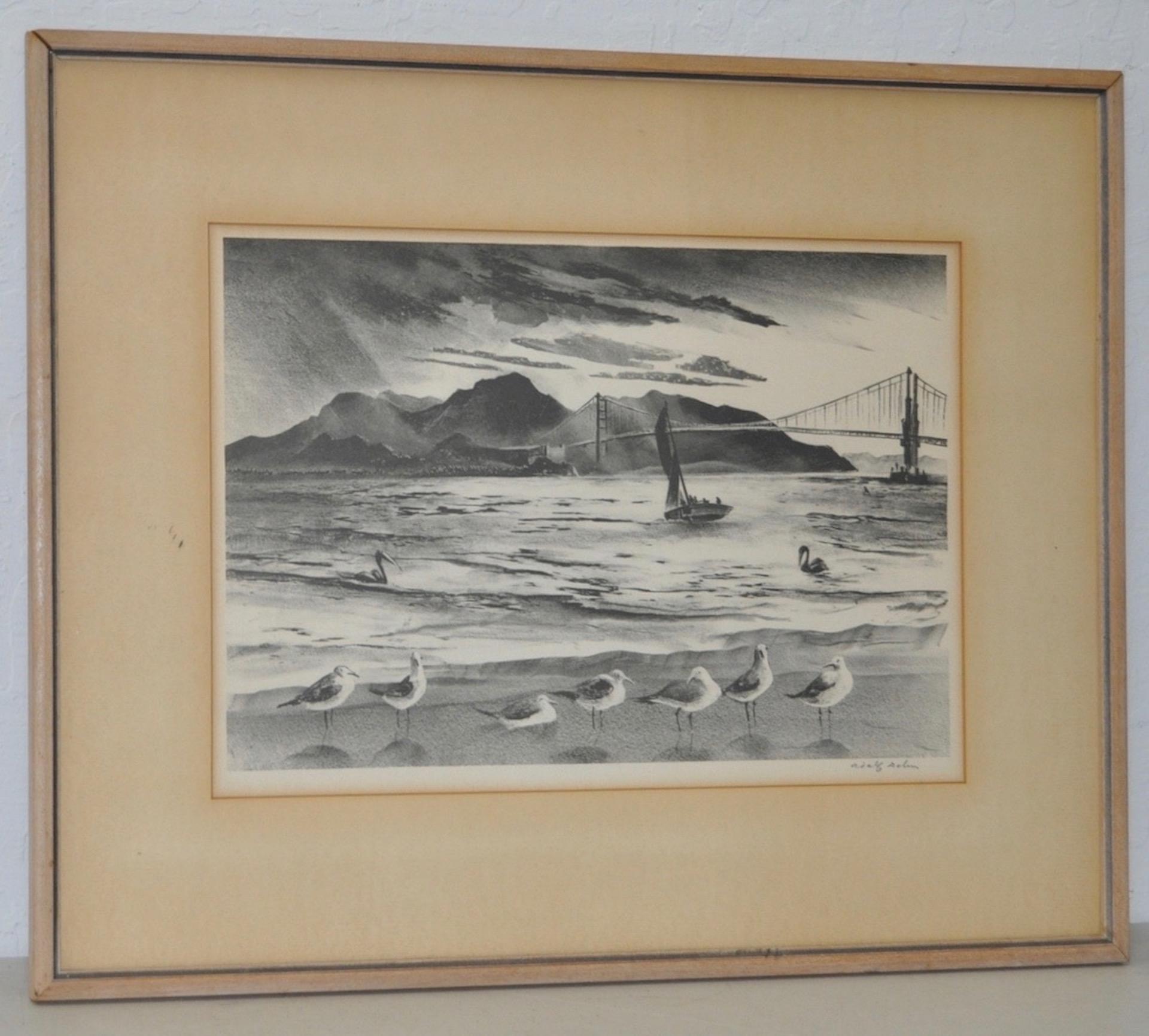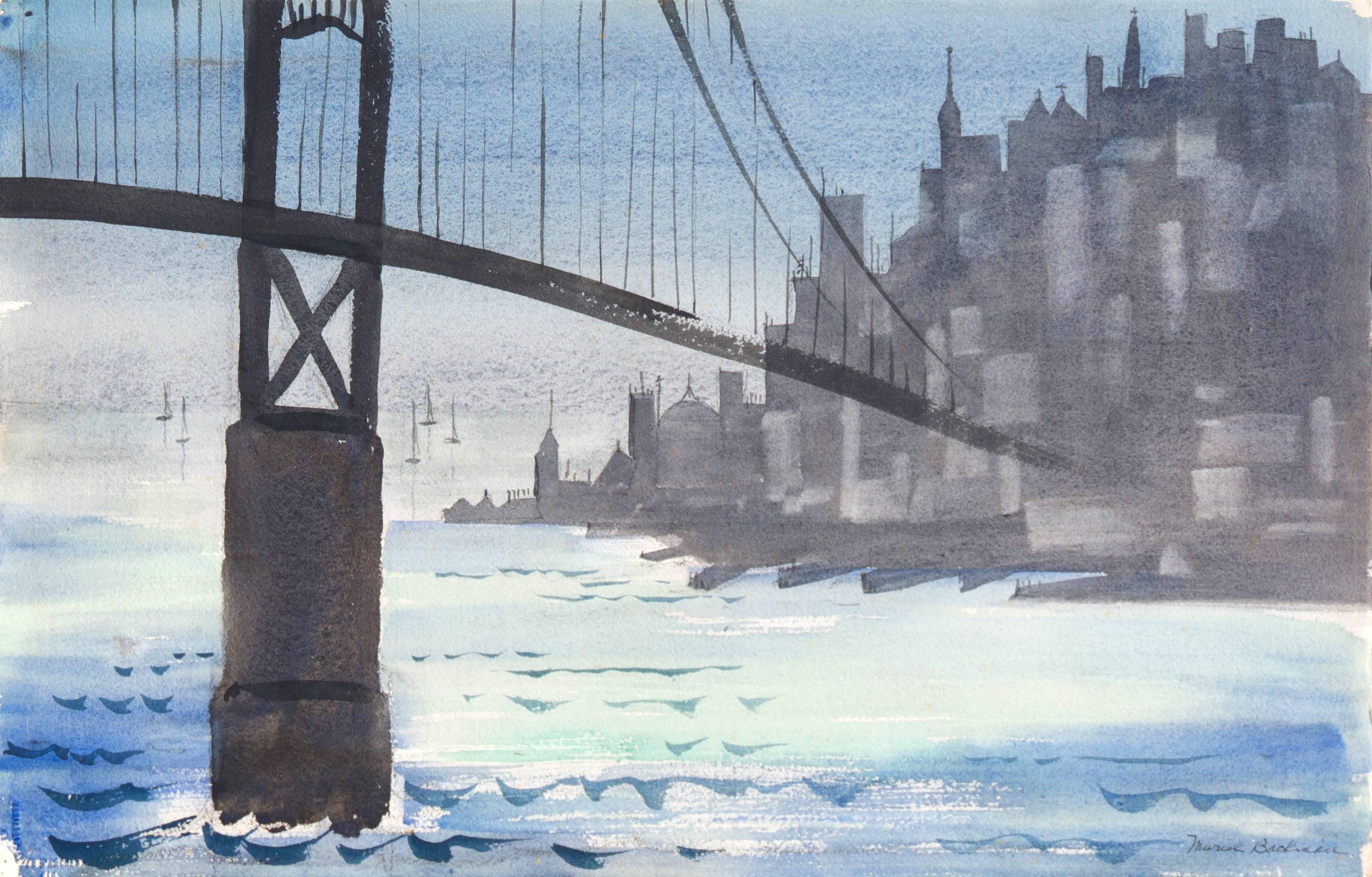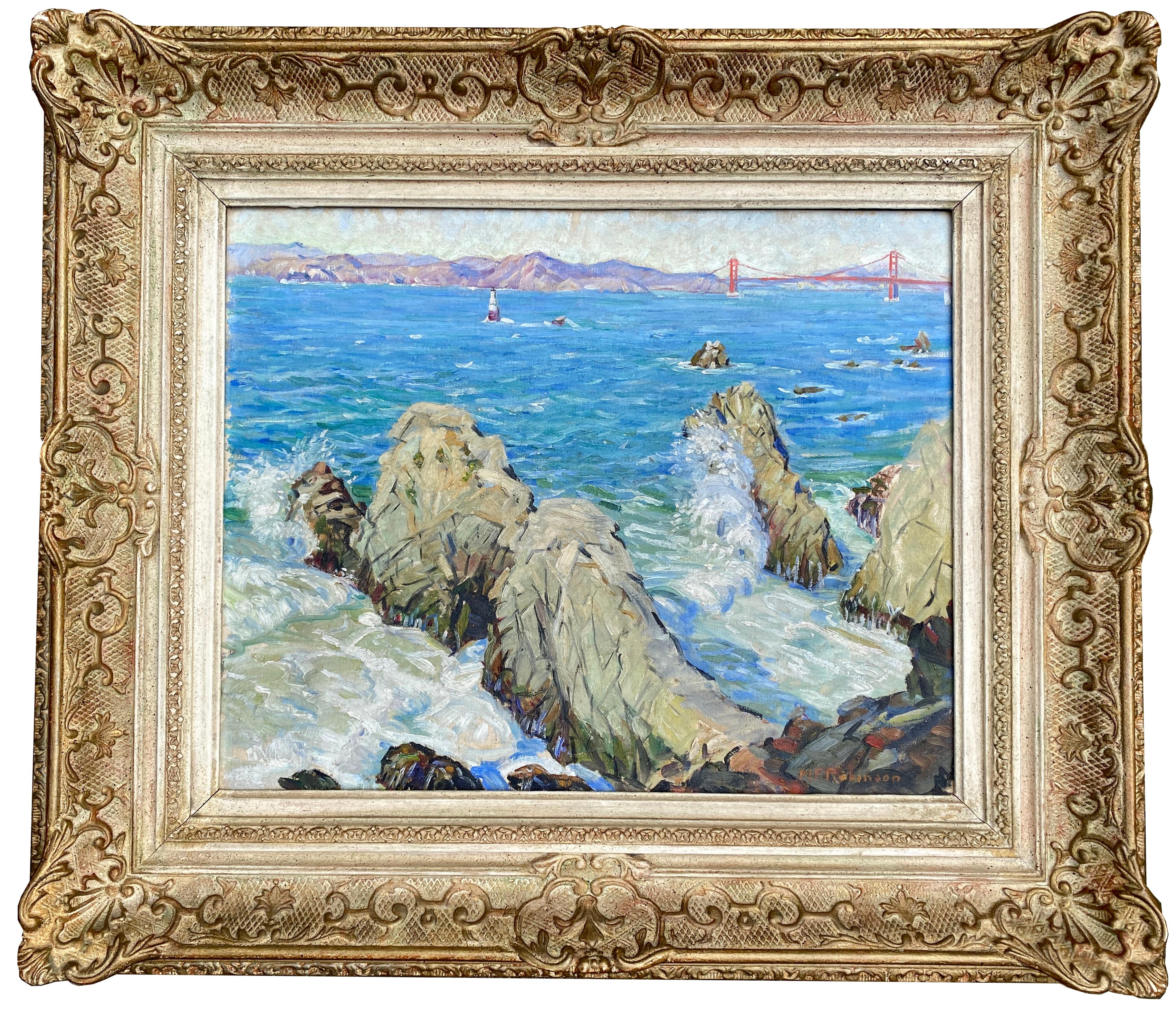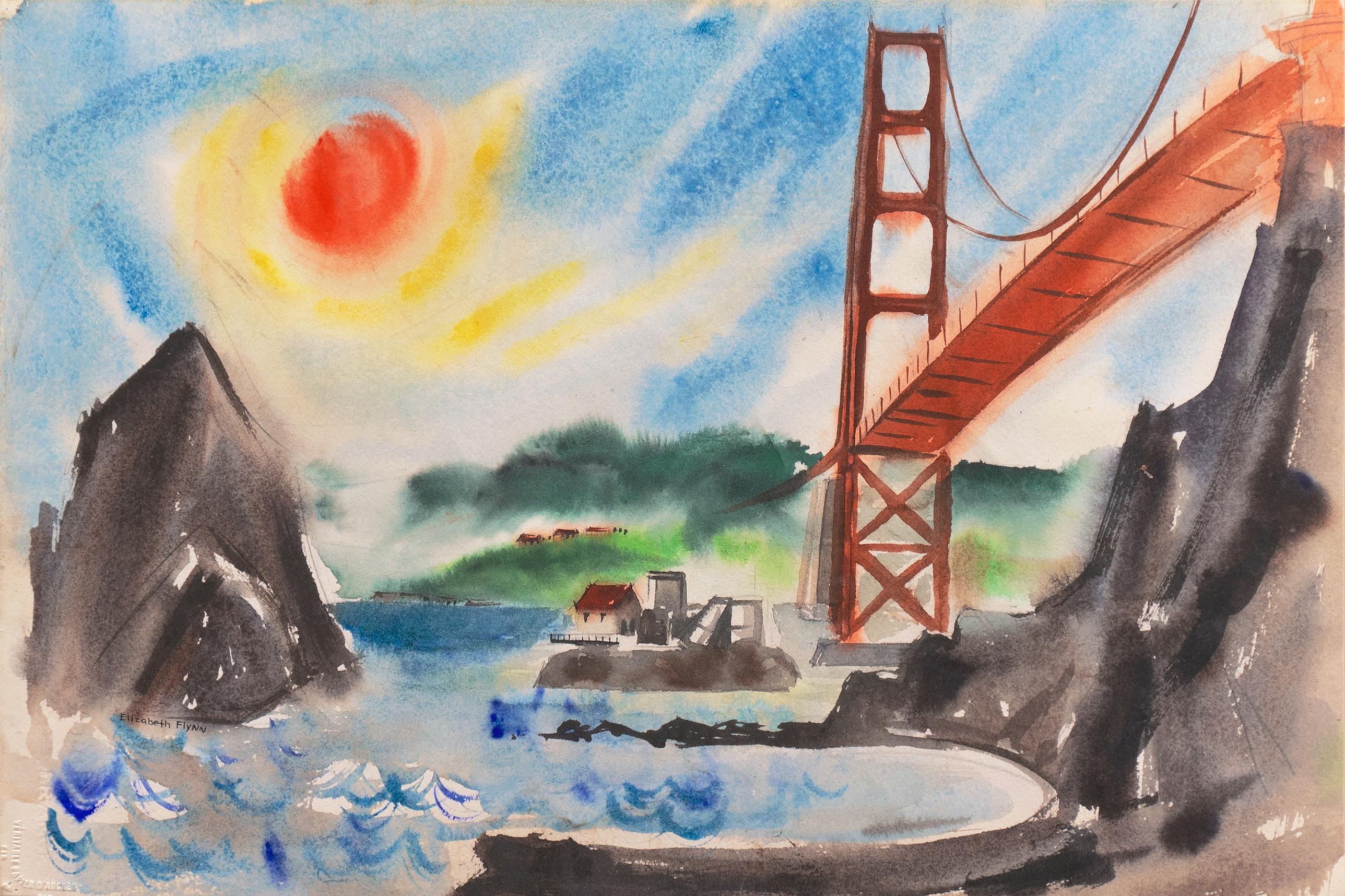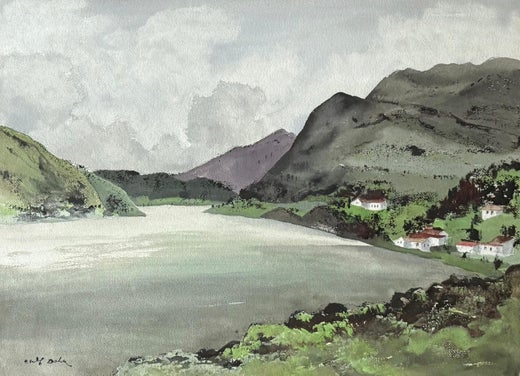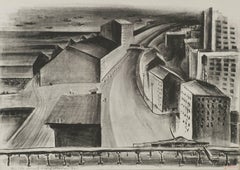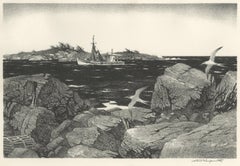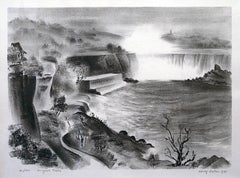Items Similar to The Golden Gate
Want more images or videos?
Request additional images or videos from the seller
1 of 9
Adolf Arthur DehnThe Golden Gate1940
1940
$2,500
£1,898.81
€2,193.75
CA$3,503.84
A$3,921.46
CHF 2,046.70
MX$47,821.55
NOK 26,194.96
SEK 24,796.88
DKK 16,371.70
Shipping
Retrieving quote...The 1stDibs Promise:
Authenticity Guarantee,
Money-Back Guarantee,
24-Hour Cancellation
About the Item
The Golden Gate
Lithograph on wove paper watermarked GC, 1940
Signed in pencil by the artist (see photo)
Publisher: Associated American Artists
Edition: 189, unnumbered
The image depicts The Golden Gate Bridge which connects San Francisco and Marin County, California
References And Exhibitions:
Illustrated: Adams, The Sensuous Life of Adolf Dehn, Fig. 13.17, page 324
Reference: L & O 325
AAA Index 391
Adolf Dehn, American Watercolorist and Printmaker, 1895-1968
Adolf Dehn was an artist who achieved extraordinary artistic heights, but in a very particular artistic sphere—not so much in oil painting as in watercolor and lithography. Long recognized as a master by serious print collectors, he is gradually gaining recognition as a notable and influential figure in the overall history of American art.
In the 19th century, with the invention of the rotary press, which made possible enormous print runs, and the development of the popular, mass-market magazines, newspaper and magazine illustration developed into an artistic realm of its own, often surprisingly divorced from the world of museums and art exhibitions, and today remains surprisingly overlooked by most art historians. Dehn in many regards was an outgrowth of this world, although in an unusual way, since as a young man he produced most of his illustrative work not for popular magazines, such as The Saturday Evening Post, but rather for radical journals, such as The Masses or The Liberator, or artistic “little magazines” such as The Dial. This background established the foundation of his outlook, and led later to his unique and distinctive contribution to American graphic art.
If there’s a distinctive quality to his work, it was his skill in introducing unusual tonal and textural effects into his work, particularly in printmaking but also in watercolor. Jackson Pollock seems to have been one of many notable artists who were influenced by his techniques.
Early Years, 1895-1922
For an artist largely remembered for scenes of Vienna and Paris, Adolf Dehn’s background was a surprising one. Born in Waterville, Minnesota, on November 22, 1895, Dehn was the descendent of farmers who had emigrated from Germany and homesteaded in the region, initially in a one-room log cabin with a dirt floor. Adolf’s father, Arthur Clark Dehn, was a hunter and trapper who took pride that he had no boss but himself, and who had little use for art. Indeed, during Adolf’s boyhood the walls of his bedroom and the space under his bed were filled with the pelts of mink, muskrats and skunks that his father had killed, skinned and stretched on drying boards. It was Adolf’s mother, Emilie Haas Dehn, a faithful member of the German Lutheran Evangelical Church, who encouraged his interest in art, which became apparent early in childhood. Both parents were ardent socialists, and supporters of Eugene Debs. In many ways Dehn’s later artistic achievement was clearly a reaction against the grinding rural poverty of his childhood.
After graduating from high school in 1914 at the age of 19—an age not unusual in farming communities at the time, where school attendance was often irregular—Dehn attended the Minneapolis School of Art from 1914 to 1917, whose character followed strongly reflected that of its director, Munich-trained Robert Kohler, an artistic conservative but a social radical. There Dehn joined a group of students who went on to nationally significant careers, including Wanda Gag (later author of best-selling children’s books); John Flanagan (a sculptor notable for his use of direct carving) Harry Gottlieb (a notable social realist and member of the Woodstock Art Colony), Elizabeth Olds (a printmaker and administrator for the WPA), Arnold Blanch (landscape, still-life and figure painter, and member of the Woodstock group), Lucille Lunquist, later Lucille Blanch (also a gifted painter and founder of the Woodstock art colony), and Johan Egilrud (who stayed in Minneapolis and became a journalist and poet).
Adolf became particularly close to Wanda Gag (1893-1946), with whom he established an intense but platonic relationship. Two years older than he, Gag was the daughter of a Bohemian artist and decorator, Anton Gag, who had died in 1908. After her husband died, Wanda’s mother, Lizzi Gag, became a helpless invalid, so Wanda was entrusted with the task of raising and financially supporting her six younger siblings. This endowed her with toughness and an independent streak, but nonetheless, when she met Dehn, Wanda was Victorian and conventional in her artistic taste and social values. Dehn was more socially radical, and introduced her to radical ideas about politics and free love, as well as to socialist publications such as The Masses and The Appeal to Reason.
Never very interested in oil painting, in Minneapolis Dehn focused on caricature and illustration--often of a humorous or politically radical character. In 1917 both Dehn and Wanda won scholarships to attend the Art Students League, and consequently, in the fall of that year both moved to New York. Dehn’s art education, however, ended in the summer of 1918, shortly after the United States entered World War I, when he was drafted to serve in the U. S. Army. Unwilling to fight, he applied for status as a conscientious objector, but was first imprisoned, then segregated in semi-imprisonment with other Pacifists, until the war ended. The abuse he suffered at this time may well explain his later withdrawal from taking political stands or making art of an overtly political nature. After his release from the army, Dehn returned to New York where he fell under the spell of the radical cartoonist Boardman Robinson and produced his first lithographs. He also finally consummated his sexual relationship with Wanda Gag.
The Years in Europe: 1922-1929
In September of 1921, however, he abruptly departed for Europe, arriving in Paris and then moving on to Vienna. There in the winter of 1922 he fell in love with a Russian dancer, Mura Zipperovitch, ending his seven-year relationship with Wanda Gag. He and Mura were married in 1926. It was also in Vienna that he produced his first notable artistic work.
Influenced by European artists such as Jules Pascin and Georg Grosz, Dehn began producing drawings of people in cafes, streets, and parks, which while mostly executed in his studio, were based on spontaneous life studies and have an expressive, sometimes almost childishly wandering quality of line. The mixture of sophistication and naiveté in these drawings was new to American audiences, as was the raciness of their subject matter, which often featured pleasure-seekers, prostitutes or scenes of sexual dalliance, presented with a strong element of caricature. Some of these drawings contain an element of social criticism, reminiscent of that found in the work of George Grosz, although Dehn’s work tended to focus on humorous commentary rather than savagely attacking his subjects or making a partisan political statement. Many Americans, including some who had originally been supporters of Dehn such as Boardman Robinson, were shocked by these European drawings, although George Grocz (who became a friend of the artist in this period) admired them, and recognized that Dehn could also bring a new vision to America subject matter. As he told Dehn: “You will do things in America which haven’t been done, which need to be done, which only you can do—as far at least as I know America.”
A key factor in Dehn’s artistic evolution at this time was his association with Scofield Thayer, the publisher of the most notable modernist art and poetry magazine of the period, The Dial. Thayer was in Vienna being analyzed by Freud, and hired Dehn to serve as his secretary and assistant, and to supervise a portfolio of reproductions of modern art—a project which gave Dehn the equivalent of an advanced graduate tutorial in the most advanced modern art being produced in Europe at that time. Among his friends at this time was the poet and painter e. e. cummings—a Harvard classmate of Thayer.
Dehn also produced lithographs, starting in 1922, working both with a virtuosos Berlin printmaker, Meister Schulz, and a Parisian master printer, Desjobert. It was in this field that he produced arguably the most influential work of his career—lithographs in which he moved away from simply drawing with a sharp crayon and introduced a variety of unusual textural effects, such as scrubbing erasing, and scraping, with a variety of tools ranging from razor blades to sandpaper, as well as the use of washes and ink wash (known as tusche) to create effects of overall tone. As Dehn himself later replained:
When I started drawing on stone, there was one traditional way of making a lithograph. It was the approach of the purist. Neatness and the smooth surface were the highest virtues. The student was cautioned, “Don’t do this, don’t do that,” The only thing one was allowed to do was to sharpen the crayon, preferably a hard one, to the finest possible point and then stroke the one for days on end until a clean little design had been developed. It is of course evident that beautiful and great prints can be made in this manner, but this delicate and careful way o drawing was stifling for some of us. It killed the creative impulse, deadened the hand.
Dehn’s innovations had very widespread influence, and ultimately reshaped the entire character of American printmaking, producing prints that had the tonal and textural richness of a painting. In June 1937, for example, in an article in The London Studio, the virtuoso lithographer Stow Wengenroth concluded a description of a group of notable lithographs with a print by Dehn which he singled out a “The most complicated of the techniques her illustrated… Precisely the order in which the various parts were done would be hard to say.”
Dehn lived principally in Vienna from 1922 to 1926, at which point his principal residence became Paris, although in this period he was rather peripatetic, and also lived for significant periods of time in Berlin and London. During the late twenties, Dehn held regular shows of his work at the Weyhe Gallery, managed by Carl Zigrosser, which did a great deal to establish his reputation as a leading American printmaker and were also modestly successful from the financial standpoint.
The Difficult Years: 1929-1936
After the financial crash of 1929, however, sales of his prints dropped significantly, and in 1933 Zigrosser declined to stage an exhibition of his most recent prints, regarding it as not worth doing from a business standpoint. For the next few years, Dehn scrambled to earn enough to survive, often spent the summer staying with his parents in Minnesota to save money on rent, and took part in a number of unprofitable business ventures, including the short-lived Adolf Dehn Print Club. For a time he even worked for the WPA at a salary of $34 a week. Around 1932-33 his marriage to Mura Zipperovitch came to an end, and for the next three summers he carried on a romance on Martha’s Vineyard with a poet named Eileen Lake. Interestingly, Jackson Pollock was also staying nearby on Martha’s Vineyard at this time, and seems to have been influenced at this time by Dehn’s innovations in printmaking, particularly his rich textural effects.
1936-1943: Watercolor and the American Scene
Around 1936, however, he began to rebuild his career. That year he travelled to Vienna, to supervise trial-proofs of reproductions of American paintings, and then spent a few weeks traveling along the Dalmatian coast and visiting Venice and Paris. On the return voyage he did something he had thought about for years but never carried through: he took up watercolor. Remarkably, up to this point in his career--he was forty-two—aside from a few pastels, he had never worked in color. From the first, he used the medium in a way which created rich textural effects, in a fashion very unusual for the period—for example, working on water-soaked paper, or creating contrasts between transparent and opaque pigment. From the first his watercolors sold readily and received enthusiastic critical acclaim. Indeed, in his book American Watercolor and Winslow Homer, the noted scholar and museum curator Lloyd Goodrich ranked Dehn as one of the half-dozen most significant American watercolorists—as a peer of such masters as Winslow Homer, Maurice Prendergast, John Marin and Edward Hopper.
In addition, in 1938 he began producing lithographs for Associated American Artists, a print-making venture established by a marketing genius, Reeves Lowenthal, who advertised his wares in national magazines and sold them in department stores. This venture also resulted in a steady stream of income. By this time, he had a new girlfriend, Elizabeth Timmerman, who was both an actress and a photographer for Life magazine. In 1940 he received a Guggenheim grant which enabled him to take a long sketching trip around the United States, and this resulted in both a sell-out exhibition at Associated American Artists, and an article of August 11, 1941 in Life magazine, which had a circulation of millions, and brought him instant fame. At this point the American Scene movement, led by figures such as Grant Wood and Thomas Hart Benton, was getting national attention. Dehn’s work fit squarely into this new artistic tendency.
An interesting outgrowth of this trip was that Dehn visited the Colorado Springs Fine Arts Center in Colorado Springs, where his former mentor, Boardman Robinson, had become head of the art school. For the next several summers he returned to Colorado Springs, to teach. An outgrowth of this activity was a major group of landscape lithographs, produced with Lawrence Barrett, who had established a lithography studio at the school, as well as his most important book illustrations, for an edition of the stories of Guy de Maupassant. He and Barrett also co-authored a textbook on lithography, How to Draw and Print Lithographs, which was published by the American Artists Group in 1950. When World War II broke out, Dehn was too old to join the army, but supported the war effort through a series of war-related projects, engineered by Reeves Lowenthal, including one documenting Navy Blimps and another celebrating the huge oil refineries at Baton Rouge.
The Late Years: 1943-1968
Dehn’s romance with Elizabeth Timmerman seems to have floundered in the early 1940s, but in 1943 he met a beautiful young woman, Virginia Engelman, twenty-three years his junior, who was working in the print department of Associated American Artists. After four years of courtship, he married her in 1947, and at that point entered into the final phase of his career—one marked by considerable financial success and domestic harmony. By this time “realist” artists such as Dehn were being pushed out of the spotlight in the New York art world by the rise of Abstract Expressionism and other radical modern styles. Nonetheless, during this period Dehn probably achieved the peak of his national fame and financial success with his prints and watercolors, many of them celebrating exotic or tropical locales such as Cuba, Haiti, the Yucatan, Italy Greece, Turkey, Iran, Afghanistan and India. About every other year he would schedule several weeks of intense works the Desjobert lithography shops in Paris, where he continued to experiment with new techniques, including his first color prints. Some of Dehn’s most popular work was produced during this period, including a watercolor titled Spring in Central Park, owned by the Metropolitan Museum of Art, which has been widely reproduced on everything from calendars and handbags—and rivals the most famous works in the collection in its popularity. During this period he continued to work at a frantic pace, although he suffered from a series of health problems, including hypertension and insomnia. The end came suddenly. On May 19, 1968, while organizing prints in his field, he suffered a massive heart attack. At the time two major projects were already in the works to celebrate his career: a book of his drawings, published by the University of Missouri Press, and a retrospective exhibition of his work organized by Mahonri Sharp Young at the Columbus Gallery of Fine Arts in Columbus, Ohio.
Dehn’s Place in the History of Art
Where does Dehn stand in the history of art? While he never did much in oil painting, in printmaking and watercolor he ranks nearly on a par with the very greatest American masters of this medium. His lithographs of the ‘twenties, with their frank depiction of nightclubs, with their performers, prostitutes, and portly patrons, introduced a new note of social satire into American printmaking; and he was one of the most gifted printmakers of the American Scene movement of the 1930s, nearly on a rank with figures such as Thomas Hart Benton and Grant Wood. Undoubtedly the most unique quality of Dehn’s work was his extraordinary exploration of new textures and techniques, which moves lithography away from mere crayon drawing into a new creative realm.
In his day, Dehn was widely regarded as one of the greatest of contemporary lithographers. Indeed, by the time of his death Dehn’s work was represented in the collections of over fifty major art museums in both Europe and the United States, including the Metropolitan Museum of Art; the Whitney Museum of American Art, the Museum of Fine Arts, Boston; The Brooklyn Museum,; the Minneapolis Institute of Fine Arts; the New York Public Library; the British Museum; the Kupferstick Kabinet in Berlin; and the Albertina in Vienna.
“Few artists have ever made the lithographic stone work as Dehn has, got so much richness out of it, so large a range of color, so tremendously sensuous an effect” wrote Guy Pene DuBois in Creative Art. “The scope of lithography seems to have been enlarged, thanks to his artist, by many leagues,” wrote Edward Alden Jewell in The New York Times.
Clinton Adams, who wrote the major book on American lithography, noted that Dehn had an extraordinary influence on his fellow artists. As Virginia Dehn recalled:
Adams told me at lunch the other day that Adolf worked with many printers that his artistic influence was very widespread. As a result of working with new litho techniques Adolf devised they were able to go ahead and suggest the techniques to other artists they worked with.
In a rather similar fashion, his watercolors rank with the best produced in American art of their period, and are also notable for their lively range of subject matter and highly creative use of new techniques.
For Dehn himself, art was primarily a way of connecting with life. Virginia Dehn recalled:
“He never made statements about his greatest contributions as an artist. He was essentially a modest man. Nor did he ever to my knowledge say that that he was a stronger technician than anyone else. He did have, I think, a quite belief in his achievements in lithography and watercolor.”
When asked late in life to produce a statement for a show of his work at St. Olaf College, in Northfield, Minnesota, Dehn chose to produce a sort of anti-statement—a plea that art is something that shouldn’t be reduced to an explanation. Along the way he slipped in a few digs at the abstract crowd, who he felt had reduced art to something to puzzle over rather than to enjoy. As he wrote:
You ask for a statement concerning my work. So my statement is a statement against making a statement. My paintings are my statement. What I have to offer as a painter is direct and simple and words are not necessary to a greater understanding or enjoyment of them. If anyone does not understand then words will not help him. I cannot imagine El Greco or Rembrandt or Renoir being asked for a statement every time they showed a painting, or if they were asked troubling to write one. Let us leave such statement, which are often grandiloquent, high sounding and ambiguous to the avant-garde boys who make them. Their paintings bewilder the dear pubic whom we all want to educate and their statements only add to the befuddlement.
Surely Dehn’s central goal was not to change the history of art, but to provide a sort of living record of the life he lived, and to give delight to the viewer. He once declared that “the very act of drawing made me participate in the life around me,” and as he once wrote:
“My attitude to life is rather sensuous—and sensual too—and only after I have filled myself with sensuous experiences can I go about working. Putting it simply: when I am fed up, I work. I am crazy about life and want to have as much out of it as I can. Take away my work and I lose interest in life, yet the work comes after my living life, or rather out of it.”
Looking at his work--even at the satires which have an element of the gothic and morbid
-- it is hard not to feel delight both in the work itself and in one’s sense of a life well lived.
Note: L & O 325
Sheet: 12 x 16";
Image: 9 15/16 x 13 5/8"
- Creator:Adolf Arthur Dehn (1895-1968, American)
- Creation Year:1940
- Dimensions:Height: 12 in (30.48 cm)Width: 16 in (40.64 cm)
- Medium:
- Movement & Style:
- Period:
- Condition:Very slight mat stain, full margins.
- Gallery Location:Fairlawn, OH
- Reference Number:Seller: FA105231stDibs: LU14012945662
Adolf Arthur Dehn
Adolf Dehn, printmaker, watercolorist, and illustrator, was born in Waterville, Minnesota, in 1895. In 1914 he began studying at the Minneapolis School of Art, and in 1917, the year his first published drawing appeared in the progressive magazine, The Masses, he received a scholarship to study at the Art Students League in New York. There he worked with Kenneth Hayes Miller and was introduced to lithography by Boardman Robinson. While in New York, Dehn threw himself into liberal politics. Declaring himself a conscientious objector in 1918, he was forced to spend four months in a Spartanburg, South Carolina, boot camp for refusing to serve in the armed forces and eight months as a volunteer instructor teaching painting and drawing at a hospital for war victims in Asheville, North Carolina. Dehn spent the years 1920 to 1929 in art-related travel in Europe, primarily in Vienna and in Paris, where he made lithographs at the Atelier Desjobert. Throughout this time, Dehn exhibited his work at the Weyhe Gallery in New York and contributed drawings both to magazines abroad and to the radical journal The Masses. Upon his return to New York in 1929, he became a leading figure in printmaking circles, exhibiting his prints to considerable critical acclaim. In 1937, Dehn had worked exclusively in black and white until 1937—halfway through his career—when he began to work in watercolor. During his summer visits to Minnesota, he created a large body of regional watercolors depicting the lakes and farms of his home state. Lithography and watercolor remained his two primary media, and his subjects ranged from social satire to naturalistic landscapes. He authored the treatise, Water Color Painting, in 1945 and two other instructional books on lithography and watercolor in 1950 and 1955. From 1938 to 1939 he taught at Stephens College in Columbia, Missouri, and during the summers of 1940-1942 he taught at the Colorado Springs Fine Arts Center. In 1939 and 1951 Dehn received Guggenheim Fellowships, and 1961 he was elected Full Academician to the National Academy of Design. Dehn exhibited throughout his career, and his works are in the permanent collections of the Metropolitan Museum of Art, the Museum of Modern Art, the Art Institute of Chicago, the Museum of Fine Arts in Boston, and the British Museum, among others. Adolf Dehn died in New York in 1968.
About the Seller
5.0
Recognized Seller
These prestigious sellers are industry leaders and represent the highest echelon for item quality and design.
Gold Seller
Premium sellers maintaining a 4.3+ rating and 24-hour response times
Established in 1978
1stDibs seller since 2013
798 sales on 1stDibs
Typical response time: <1 hour
Associations
International Fine Print Dealers Association
- ShippingRetrieving quote...Shipping from: Fairlawn, OH
- Return Policy
Authenticity Guarantee
In the unlikely event there’s an issue with an item’s authenticity, contact us within 1 year for a full refund. DetailsMoney-Back Guarantee
If your item is not as described, is damaged in transit, or does not arrive, contact us within 7 days for a full refund. Details24-Hour Cancellation
You have a 24-hour grace period in which to reconsider your purchase, with no questions asked.Vetted Professional Sellers
Our world-class sellers must adhere to strict standards for service and quality, maintaining the integrity of our listings.Price-Match Guarantee
If you find that a seller listed the same item for a lower price elsewhere, we’ll match it.Trusted Global Delivery
Our best-in-class carrier network provides specialized shipping options worldwide, including custom delivery.More From This Seller
View AllBrooklyn Waterfront
By Adolf Arthur Dehn
Located in Fairlawn, OH
Brooklyn Waterfront
Lithograph, 1931
Signed, titled, and dated in pencil by the artist
Edition: Undetermined (very small), plus artist's proofs
Printed by Meister Schulz, Berlin
Provenance:
Estate of the artist
Virginia Dehn, the artist's widow
Dehn Quests
Bibliography:
Lumsdaine and O'Sullivan 152
Illustrated: Adams, The Sensuous Life of Adolf Dehn, Fig. 9.14, page 213 (This impression)
Adolf Dehn, American Watercolorist and Printmaker, 1895-1968
Adolf Dehn was an artist who achieved extraordinary artistic heights, but in a very particular artistic sphere—not so much in oil painting as in watercolor and lithography. Long recognized as a master by serious print collectors, he is gradually gaining recognition as a notable and influential figure in the overall history of American art.
In the 19th century, with the invention of the rotary press, which made possible enormous print runs, and the development of the popular, mass-market magazines, newspaper and magazine illustration developed into an artistic realm of its own, often surprisingly divorced from the world of museums and art exhibitions, and today remains surprisingly overlooked by most art historians. Dehn in many regards was an outgrowth of this world, although in an unusual way, since as a young man he produced most of his illustrative work not for popular magazines, such as The Saturday Evening Post, but rather for radical journals, such as The Masses or The Liberator, or artistic “little magazines” such as The Dial. This background established the foundation of his outlook, and led later to his unique and distinctive contribution to American graphic art.
If there’s a distinctive quality to his work, it was his skill in introducing unusual tonal and textural effects into his work, particularly in printmaking but also in watercolor. Jackson Pollock seems to have been one of many notable artists who were influenced by his techniques.
Early Years, 1895-1922
For an artist largely remembered for scenes of Vienna and Paris, Adolf Dehn’s background was a surprising one. Born in Waterville, Minnesota, on November 22, 1895, Dehn was the descendent of farmers who had emigrated from Germany and homesteaded in the region, initially in a one-room log cabin with a dirt floor. Adolf’s father, Arthur Clark Dehn, was a hunter and trapper who took pride that he had no boss but himself, and who had little use for art. Indeed, during Adolf’s boyhood the walls of his bedroom and the space under his bed were filled with the pelts of mink, muskrats and skunks that his father had killed, skinned and stretched on drying boards. It was Adolf’s mother, Emilie Haas Dehn, a faithful member of the German Lutheran Evangelical Church, who encouraged his interest in art, which became apparent early in childhood. Both parents were ardent socialists, and supporters of Eugene Debs...
Category
1920s American Modern Landscape Prints
Materials
Lithograph
New England Coast (Greenport, New York)
By Stow Wengenroth
Located in Fairlawn, OH
New England Coast (Greenport, New York)
Lithograph, 1969
Signed in pencil lower right (see photo)
Edition: 350
Published in the book, Stow Wengenroth's New York, 1969
Limited slipcas...
Category
1960s American Realist Landscape Prints
Materials
Lithograph
Boulder Dam
By Adolf Dehn
Located in Fairlawn, OH
Boulder Dam
Lithograph, 1946
Signed and dated in pencil lower right (see photo)
Titled in pencil lower left (see photo)
Printed by Lawrence Barrett, Colorado Springs
Edition of 40 or...
Category
1940s American Modern Landscape Prints
Materials
Lithograph
Niagara Falls
By Adolf Arthur Dehn
Located in Fairlawn, OH
Niagara Falls
Lithograph, 1931
Signed lower right (see photo)
Titled/edition lower left. (see photo)
Edition of 25
Provenance: the Estate of the Artist
Condition: Excellent
Image si...
Category
1930s American Modern Landscape Prints
Materials
Lithograph
Trout Fishing on the Gunnison (Colorado)
By Adolf Dehn
Located in Fairlawn, OH
Trout Fishing on the Gunnison (Colorado)
Lithograph, 1941
Signed and dated '42 in pencil lower right
Annotated lower left:
"40 Prints-The Gunnison River, Colorado-For Anne & Jack"
Ed...
Category
1940s American Modern Landscape Prints
Materials
Lithograph
Snow Mountain (or Lake in the Mountains)
By Adolf Arthur Dehn
Located in Fairlawn, OH
Signed lower right
Edition: Undetermined, plus an artist's edition of 10
Edition: Undetermined, plus an artist's edition of 10
Published by the Associated American Artist
...
Category
1960s Landscape Prints
Materials
Lithograph
You May Also Like
Adolph Dehn "Golden Gate" Lithograph c.1940
Located in San Francisco, CA
Adolph Dehn "Golden Gate" Lithograph c.1940
Fine pencil signed lithograph issued by Associated American Artists, New York
Edition size 200.
Dimensions 1...
Category
Mid-20th Century Impressionist Landscape Prints
Materials
Lithograph
Golden Gate, San Francisco, California
By Luigi Kasimir
Located in San Francisco, CA
This artwork titled "Golden Gate, San Francisco, California" c.1930 is a color etching on watermarked Kasimir Vienna paper by Austrian artist Luigi Kasimir, 1881-1962. It is hand sig...
Category
Early 20th Century Realist Figurative Prints
Materials
Etching
'Golden Gate, San Francisco', Bay Area Woman Modernist, Crocker Art Museum
By Muriel Backman
Located in Santa Cruz, CA
Signed lower right "Muriel Backman" for Muriel Durgin Backman (American, 1902-1996) and titled verso "The Cool Gray City".
An elegant mid-century view of the San Francisco skyline a...
Category
1950s Modern Landscape Paintings
Materials
Watercolor, Gouache, Handmade Paper
Golden Gate Bridge, San Francisco
By Fanch (Francois Ledan)
Located in San Francisco, CA
This artwork titled "Golden Gate Bridge, San Francisco" 1988 is a original colors lithograph on Arches paper by French artist (Fanch, Francois Ledan, born 1949) It is hand signed and inscribed A.P. (Artist Proof) in pencil by the artist. The image size is 26 x 19.5 inches, framed is 37.25 x 31.25 inches. Published and printed by Art Estampes, Paris. Custom framed in a wooden gold frame, with off white matting. It is in excellent condition, the frame has a minor restoration at the lower right side corner, practically invisible.
About the artist:
Francois "Fanch" Ledan (b. 1949) is noted for colorful scenes of his native Brittany. In 1968 he abandoned his studies in commercial design for full-time studies in painting and fine art. His talent was quickly recognized and soon he was involved in major European shows. He became involved in printmaking in 1973 when he learned lithography in Paris. Since then he has had numerous one-person shows in Europe, North America and South America.
His paintings and lithographs from the 1970's and 1980's display characteristics often associated with "naïve" art. His views of Paris, a city which has embraced naïve art, display the attention to detail,
In the 80's he turned to more brightly colored paintings and again a connection to Impressionism. He began to work on paintings that he refers to as "interiorscapes" or "interior visions...
Category
Late 20th Century Modern Landscape Prints
Materials
Lithograph
‘Golden Gate Bridge, Californian Coast’ by Margaret France Robinson, 1908 – 1985
Located in Knokke, BE
Margaret France Robinson
New Orleans 1908 – 1985
American Painter
‘Golden Gate Bridge, Californian Coast’
Signature: Signed lower right
Medium: Oil on canvas
Dimensions: Image size ...
Category
20th Century Post-Impressionist Landscape Paintings
Materials
Canvas, Oil
'Golden Gate Bridge from Sausalito', Marin, Mid-century Modernist Watercolor
Located in Santa Cruz, CA
Signed lower left, 'Elizabeth Flynn' (American, 20th century) and painted circa 1965.
A sunny, modernist view of California's Golden Gate Bridge viewed from Sausalito's Lime Point L...
Category
1960s Modern Landscape Drawings and Watercolors
Materials
Watercolor, Gouache, Laid Paper
More Ways To Browse
Golden Key
Gate Posts
Vintage Wood Gate
Victorian Fashion Lithographs
American Wood Secretary
George And Martha
Vintage Tropical Wall Art
Library Secretary
Carl Evers
Pastel Bed
Greek Bed
Vintage American Logs
Paintings Brooklyn Heights
1940s Cabin
Vintage 1950 Calendar
1940s Vintage Handbags 1940s
Vintage 1930s Handbags
Vintage Dalmatian
